Textures and Chemical Compositions of Nb-Bearing Minerals and Nb Mineralization in the Shuangshan Nepheline Syenite Pluton, East Qinling, China
Abstract
:1. Introduction
2. Geological Setting
2.1. Regional Geology
2.2. Shuangshan Alkaline Complex
3. Samples and Analytical Methods
4. Results
4.1. Pyrochlore
4.2. Zircon
4.3. Titanite
4.4. Allanite
5. Discussion
5.1. Magma Evolution and Pyrochlore Crystallization
5.2. Hydrothermal Alteration
5.3. Quantitative Evaluation of the Migration of Niobium from Hydrothermal Zircon and Titanite
6. Conclusions
Author Contributions
Funding
Acknowledgments
Conflicts of Interest
Appendix A
| Standard | Element | Counting Time (s) |
|---|---|---|
| Pyrope | Fe, Mn, Ti, Al, Si, Ca | 15 |
| Benitoite | Ba | 15 |
| Orthoclase | Na, K | 15 |
| Monazite | Y, La, Ce | 45 |
| Apatite | F | 15 |
| Anhydride | Sr | 45 |
| PbS | Pb | 15 |
| Cubic Zirconia 1 | Zr, Hf, Y | 15,45 |
| Rutile 2 | Ti | 15 |
| Diopside 2 | Ca | 15 |
| Albite 3 | Na, Al, Si | 15 |
| Almandine 4 | Fe | 15 |
| Kaersutite 4 | Na, Ca, Ti, Al, Si, Mg, K | 15 |
| MAC-Nb | Nb | 15 |
| MAC-Ta | Ta | 15 |
| MAC-U | U | 45 |
| Sample | DZ18-02 | DZ18-06 | DZ18-08 | DZ18-09 | DZ18-18 | DZ18-21 | DZ18-28 | DZ18-30 | ZK503-6 |
|---|---|---|---|---|---|---|---|---|---|
| Oxide (wt%) | |||||||||
| SiO2 | 57.26 | 56.70 | 60.38 | 57.53 | 56.99 | 52.66 | 56.76 | 56.81 | 56.11 |
| Al2O3 | 19.17 | 21.23 | 21.37 | 17.73 | 20.10 | 16.55 | 19.75 | 19.30 | 19.82 |
| TFe2O3 | 4.61 | 4.29 | 3.62 | 5.44 | 3.96 | 6.56 | 5.48 | 5.20 | 5.04 |
| MgO | 0.75 | 0.72 | 0.32 | 0.55 | 0.46 | 0.85 | 0.69 | 0.71 | 0.37 |
| CaO | 2.72 | 1.49 | 0.25 | 3.13 | 1.30 | 7.20 | 1.82 | 2.39 | 1.94 |
| Na2O | 6.80 | 5.57 | 7.44 | 5.87 | 3.72 | 4.43 | 6.21 | 7.54 | 7.88 |
| K2O | 6.00 | 6.68 | 4.12 | 7.05 | 8.87 | 6.00 | 6.70 | 5.97 | 5.27 |
| MnO | 0.33 | 0.41 | 0.37 | 0.52 | 0.34 | 0.49 | 0.40 | 0.35 | 0.25 |
| P2O5 | 0.05 | 0.05 | 0.05 | 0.05 | 0.09 | 0.20 | 0.04 | 0.05 | 0.05 |
| TiO2 | 0.47 | 0.26 | 0.30 | 0.43 | 0.64 | 0.38 | 0.58 | 0.52 | 0.50 |
| LOI | 1.51 | 1.66 | 0.99 | 1.21 | 2.62 | 3.83 | 0.68 | 0.98 | 1.67 |
| Total | 99.67 | 99.07 | 99.21 | 99.51 | 99.09 | 99.15 | 99.11 | 99.83 | 98.90 |
| Trace element (μg/g) | |||||||||
| La | 140 | 257 | 279 | 261 | 318 | 684 | 248 | 398 | 531 |
| Ce | 254 | 458 | 458 | 435 | 603 | 1431 | 358 | 627 | 791 |
| Pr | 23 | 36 | 42 | 41 | 62 | 160 | 30 | 53 | 68 |
| Nd | 72 | 105 | 123 | 123 | 206 | 553 | 82 | 154 | 190 |
| Sm | 10 | 15 | 17 | 17 | 29 | 80 | 11 | 20 | 25 |
| Eu | 1 | 1 | 2 | 2 | 3 | 9 | 1 | 2 | 3 |
| Gd | 9 | 13 | 15 | 15 | 24 | 63 | 11 | 18 | 23 |
| Tb | 2 | 2 | 2 | 2 | 3 | 9 | 2 | 3 | 3 |
| Dy | 12 | 11 | 16 | 15 | 19 | 51 | 11 | 17 | 20 |
| Ho | 3 | 3 | 4 | 3 | 4 | 10 | 2 | 4 | 4 |
| Y | 84 | 69 | 120 | 108 | 120 | 285 | 79 | 118 | 137 |
| Er | 8 | 8 | 12 | 11 | 12 | 29 | 8 | 12 | 14 |
| Tm | 1 | 1 | 2 | 2 | 2 | 4 | 1 | 2 | 2 |
| Yb | 8 | 12 | 15 | 14 | 13 | 24 | 8 | 14 | 15 |
| Lu | 1 | 2 | 2 | 2 | 2 | 3 | 1 | 2 | 2 |
| Zr | 1143 | 3447 | 2529 | 2305 | 1748 | 1230 | 2109 | 2568 | 3642 |
| Nb | 232 | 531 | 787 | 546 | 511 | 729 | 451 | 582 | 703 |
References
- Salvi, S.; Williams-Jones, A.E. Alkaline granite-syenite deposits. In Rare-Element Geochemistry and Mineral Deposits; Linnen, L., Samson, I.M., Eds.; Geological Association of Canada: St. John’s, NL, Canada, 2005; pp. 315–341. [Google Scholar]
- Linnen, R.L.; Samson, I.M.; Williams-Jones, A.E.; Chakhmouradian, A.R. Geochemistry of the Rare-Earth Element, Nb, Ta, Hf, and Zr Deposits. In Treatise on Geochemistry, 2nd ed.; Elsevier: Amsterdam, The Netherlands, 2014; pp. 543–568. [Google Scholar] [CrossRef]
- Huang, H.; Wang, T.; Zhang, Z.; Li, C.; Qin, Q. Highly differentiated fluorine-rich, alkaline granitic magma linked to rare metal mineralization: A case study from the Boziguo’er rare metal granitic pluton in South Tianshan Terrane, Xinjiang, NW China. Ore Geol. Rev. 2018, 96, 146–163. [Google Scholar] [CrossRef]
- Vasyukova, O.; Williams-Jones, A.E. Fluoride–silicate melt immiscibility and its role in REE ore formation: Evidence from the Strange Lake rare metal deposit, Québec-Labrador, Canada. Geochim. Cosmochim. Acta 2014, 139, 110–130. [Google Scholar] [CrossRef]
- Vasyukova, O.; Williams-Jones, A.E. The evolution of immiscible silicate and fluoride melts: Implications for REE ore-genesis. Geochim. Cosmochim. Acta 2016, 172, 205–224. [Google Scholar] [CrossRef] [Green Version]
- Bailey, J.; Sorensen, H.; Andersen, T.; Kogarko, L.; Rosehansen, J. On the origin of microrhythmic layering in arfvedsonite lujavrite from the Ilímaussaq alkaline complex, South Greenland. Lithos 2006, 91, 301–318. [Google Scholar] [CrossRef]
- Sheard, E.R.; Williams-Jones, A.E.; Heiligmann, M.; Pederson, C.; Trueman, D.L. Controls on the Concentration of Zirconium, Niobium, and the Rare Earth Elements in the Thor Lake Rare Metal Deposit, Northwest Territories, Canada. Econ. Geol. 2012, 107, 81–104. [Google Scholar] [CrossRef]
- Gysi, A.P.; Williams-Jones, A.E. Hydrothermal mobilization of pegmatite-hosted REE and Zr at Strange Lake, Canada: A reaction path model. Geochim. Cosmochim. Acta 2013, 122, 324–352. [Google Scholar] [CrossRef]
- Salvi, S.; Fontan, F.; Monchoux, P.; Williams-Jones, A.E.; Moine, B. Hydrothermal mobilization of high field strength elements in alkaline igneous systems: Evidence from the Tamazeght complex (Morocco). Econ. Geol. Bull. Soc. 2000, 95, 559–575. [Google Scholar] [CrossRef]
- Salvi, S.; Williams-jones, A.E. The Role of Hydrothermal Processes in the Granite-Hosted Zr, Y, Ree Deposit at Strange Lake, Quebec Labrador—Evidence from Fluid Inclusions. Geochim. Cosmochim. Acta 1990, 54, 2403–2418. [Google Scholar] [CrossRef]
- Salvi, S.; Williams-Jones, A.E. The role of hydrothermal processes in concentrating high-field strength elements in the Strange Lake peralkaline complex, northeastern Canada. Geochim. Cosmochim. Acta 1996, 60, 1917–1932. [Google Scholar] [CrossRef]
- Salvi, S.; Williams-Jones, A.E. Alteration, HFSE mineralisation and hydrocarbon formation in peralkaline igneous systems: Insights from the Strange Lake Pluton, Canada. Lithos 2006, 91, 19–34. [Google Scholar] [CrossRef]
- Adam, J.; Green, T. The influence of pressure, mineral composition and water on trace element partitioning between clinopyroxene, amphibole and basanitic melts. Eur. J. Mineral. 2003, 15, 831–841. [Google Scholar] [CrossRef]
- Timofeev, A.; Williams-Jones, A.E. The Origin of Niobium and Tantalum Mineralization in the Nechalacho REE Deposit, NWT, Canada. Econ. Geol. 2015, 110, 1719–1735. [Google Scholar] [CrossRef]
- Zhang, S.; Zhang, B.; Yuming, Z.; Junkui, C.; Danfeng, H.; Shanpo, L. Discovery of fergusonite from Dazhuang niobium rare earth deposit in Henan Province and its geological significance. Glob. Geol. 2020, 39, 282–293. [Google Scholar]
- Zhu, Y.-X.; Wang, L.-X.; Ma, C.-Q.; Wiedenbeck, M.; Wang, W. The Neoproterozoic alkaline rocks from Fangcheng area, East Qinling (China) and their implications for regional Nb mineralization and tectonic evolution. Precambrian Res. 2020, 350, 105852. [Google Scholar] [CrossRef]
- Bao, Z.; Wang, Q.; Bai, G.; Zhao, Z.; Song, Y.; Liu, X. Geochronology and geochemistry of the Fangcheng Neoproterozoic alkali-syenites in East Qinling orogen and its geodynamic implications. Sci. Bull. 2008, 53, 2050–2061. [Google Scholar] [CrossRef] [Green Version]
- Dong, Y.; Santosh, M. Tectonic architecture and multiple orogeny of the Qinling Orogenic Belt, Central China. Gondwana Res. 2016, 29, 1–40. [Google Scholar] [CrossRef]
- Wang, X.; Wang, T.; Zhang, C. Neoproterozoic, Paleozoic, and Mesozoic granitoid magmatism in the Qinling Orogen, China: Constraints on orogenic process. J. Asian Earth Sci. 2013, 72, 129–151. [Google Scholar] [CrossRef]
- Zhang, Z.; Zhu, B.; Chang, X.; Xie, J. Major element characteristics of the alkali-rich intrusive rocks zone and distribution of the subzones in the northern part of east Qinling, China. Acta Petrol. Sin. 2002, 18, 468–474. [Google Scholar]
- Zhang, Z.; Zhu, B.; Chang, X. Nd, Sr, Pb isotopic geochemistry of the alkali-rich intrusive rocks in East Qinling, central China and its tectonic significance. Geochimica 2000, 029, 455–461. [Google Scholar]
- Moller, V.; Williams-Jones, A.E. Petrogenesis of the Nechalacho Layered Suite, Canada: Magmatic Evolution of a REE–Nb-rich Nepheline Syenite Intrusion. J. Petrol. 2016, 57, 229–276. [Google Scholar] [CrossRef]
- Siegel, K.; Vasyukova, O.V.; Williams-Jones, A.E. Magmatic evolution and controls on rare metal-enrichment of the Strange Lake A-type peralkaline granitic pluton, Québec-Labrador. Lithos 2018, 308–309, 34–52. [Google Scholar] [CrossRef] [Green Version]
- Kim, E.J.; Yang, S.J.; No, S.G.; Park, S.W.; Lee, S.R.; Kim, Y.D.; Jo, J. The characteristics of zircon as the evidence for post-magmatic remobilization of REE and HFSE in the northern Motzfeldt alkaline igneous complex, southern Greenland. Geosci. J. 2018, 22, 921–938. [Google Scholar] [CrossRef]
- Schmitt, A.K.; Trumbull, R.B.; Dulski, P.; Emmermann, R. Zr-Nb-REE mineralization in peralkaline granites from the Amis Complex, Brandberg (Namibia): Evidence for magmatic pre-enrichment from melt inclusions. Econ. Geol. Bull. Soc. 2002, 97, 399–413. [Google Scholar] [CrossRef]
- Vasyukova, O.V.; Williams-Jones, A.E.; Blamey, N.J.F. Fluid evolution in the Strange Lake granitic pluton, Canada: Implications for HFSE mobilisation. Chem. Geol. 2016, 444, 83–100. [Google Scholar] [CrossRef] [Green Version]
- Putnis, A. Mineral replacement reactions: From macroscopic observations to microscopic mechanisms. Mineral. Mag. 2018, 66, 689–708. [Google Scholar] [CrossRef]
- Kempe, U.; Möckel, R.; Graupner, T.; Kynicky, J.; Dombon, E. The genesis of Zr–Nb–REE mineralisation at Khalzan Buregte (Western Mongolia) reconsidered. Ore Geol. Rev. 2015, 64, 602–625. [Google Scholar] [CrossRef]
- Yang, W.B.; Niu, H.C.; Shan, Q.; Luo, Y.; Qiu, Y.Z. Ore-forming mechanism of the Baerzhe super-large rare and rare earth elements deposit. Acta Petrol. Sin. 2009, 25, 2924–2932. [Google Scholar]
- Keppler, H. Influence of Fluorine on the Enrichment of High-Field Strength Trace-Elements in Granitic-Rocks. Contrib. Mineral. Petrol. 1993, 114, 479–488. [Google Scholar] [CrossRef]
- Moller, V.; Williams-Jones, A.E. Magmatic and Hydrothermal Controls on the Mineralogy of the Basal Zone, Nechalacho REE-Nb-Zr Deposit, Canada. Econ. Geol. 2017, 112, 1823–1856. [Google Scholar] [CrossRef]
- Bonazzi, P. Single-crystal diffraction and transmission electron microscopy studies of "silicified" pyrochlore from Narssarssuk, Julianehaab district, Greenland. Am. Mineral. 2006, 91, 794–801. [Google Scholar] [CrossRef]
- Atencio, D.; Andrade, M.B.; Christy, A.G.; Giere, R.; Kartashov, P.M. The Pyrochlore Supergroup of Minerals: Nomenclature. Can. Mineral. 2010, 48, 673–698. [Google Scholar] [CrossRef]
- Timofeev, A.; Migdisov, A.A.; Williams-Jones, A.E. An experimental study of the solubility and speciation of niobium in fluoride-bearing aqueous solutions at elevated temperature. Geochim. Cosmochim. Acta 2015, 158, 103–111. [Google Scholar] [CrossRef]
- Akinfiev, N.N.; Korzhinskaya, V.S.; Kotova, N.P.; Redkin, A.F.; Zotov, A.V. Niobium and tantalum in hydrothermal fluids: Thermodynamic description of hydroxide and hydroxofluoride complexes. Geochim. Cosmochim. Acta 2020, 280, 102–115. [Google Scholar] [CrossRef]
- Salvi, S.; Williamsjones, A.E. Zirconosilicate Phase-Relations in the Strange Lake (Lac-Brisson) Pluton, Quebec-Labrador, Canada. Am. Mineral. 1995, 80, 1031–1040. [Google Scholar] [CrossRef]
- Ballouard, C.; Massuyeau, M.; Elburg, M.A.; Tappe, S.; Viljoen, F.; Brandenburg, J.-T. The magmatic and magmatic-hydrothermal evolution of felsic igneous rocks as seen through Nb-Ta geochemical fractionation, with implications for the origins of rare-metal mineralizations. Earth-Sci. Rev. 2020, 203, 103115. [Google Scholar] [CrossRef]
- McNeil, A.G.; Linnen, R.L.; Flemming, R.L. Solubility of wodginite, titanowodginite, microlite, pyrochlore, columbite-(Mn) and tantalite-(Mn) in flux-rich haplogranitic melts between 700 °C and 850 °C and 200 MPa. Lithos 2020, 352–353, 105239. [Google Scholar] [CrossRef]
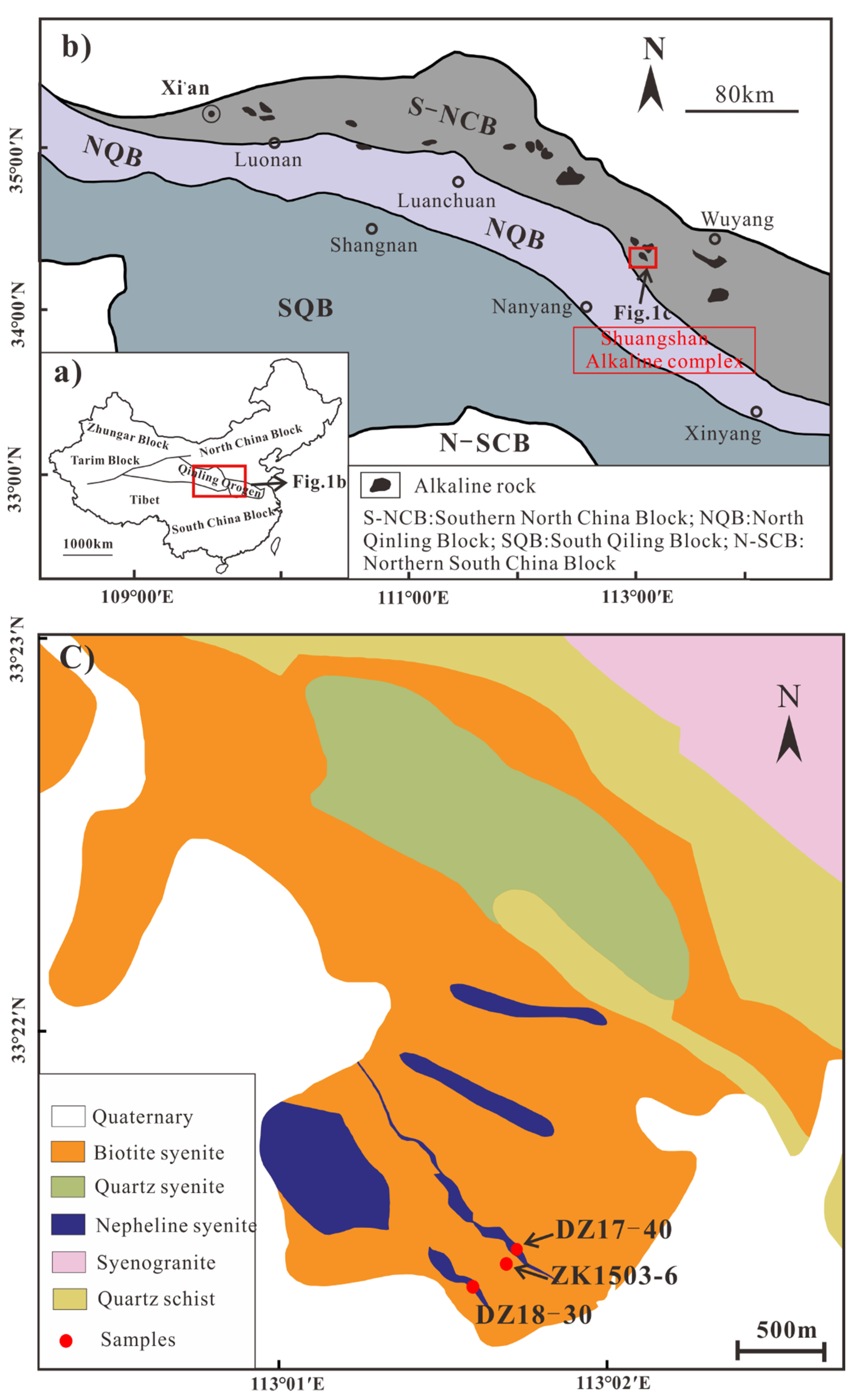
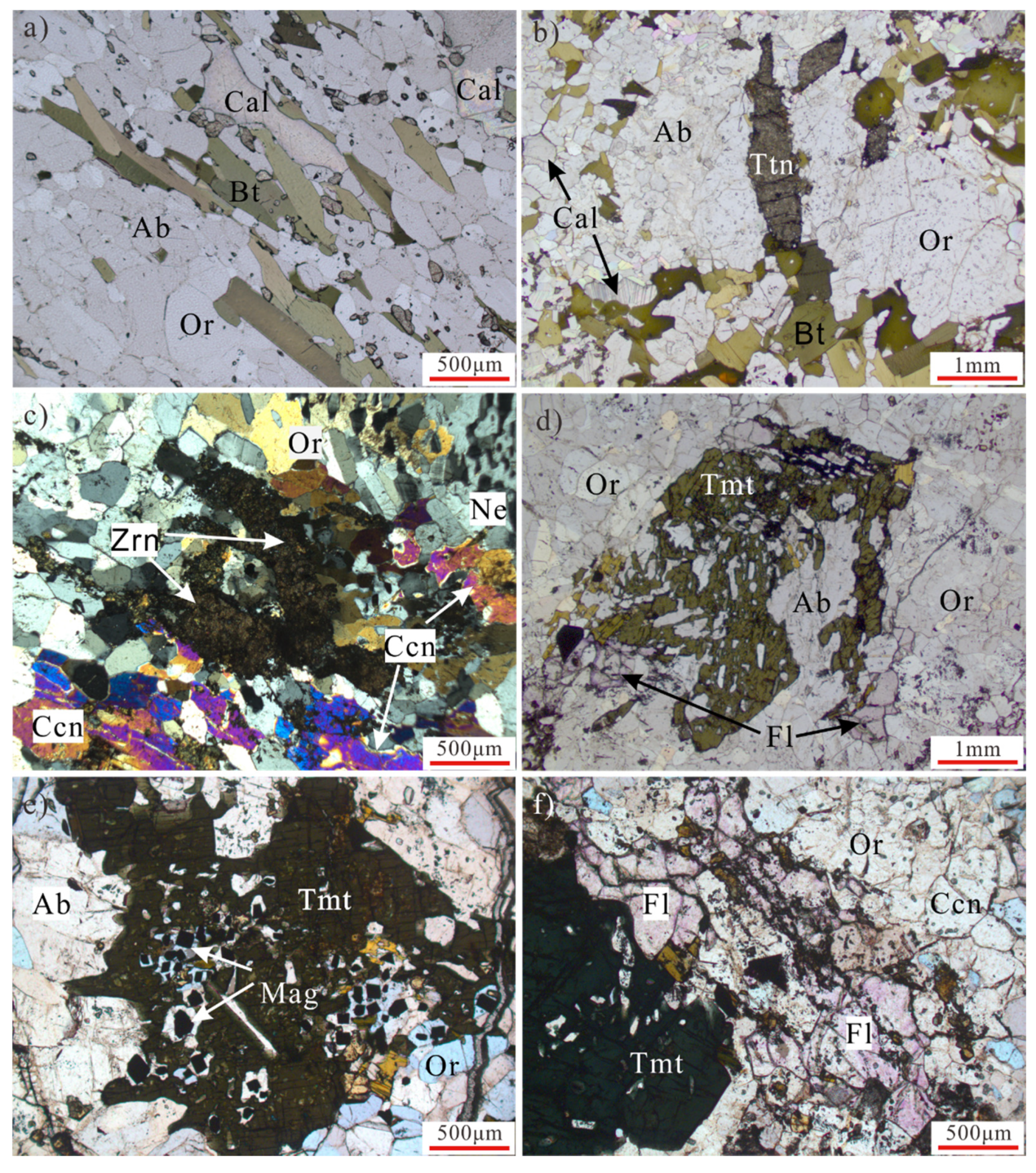
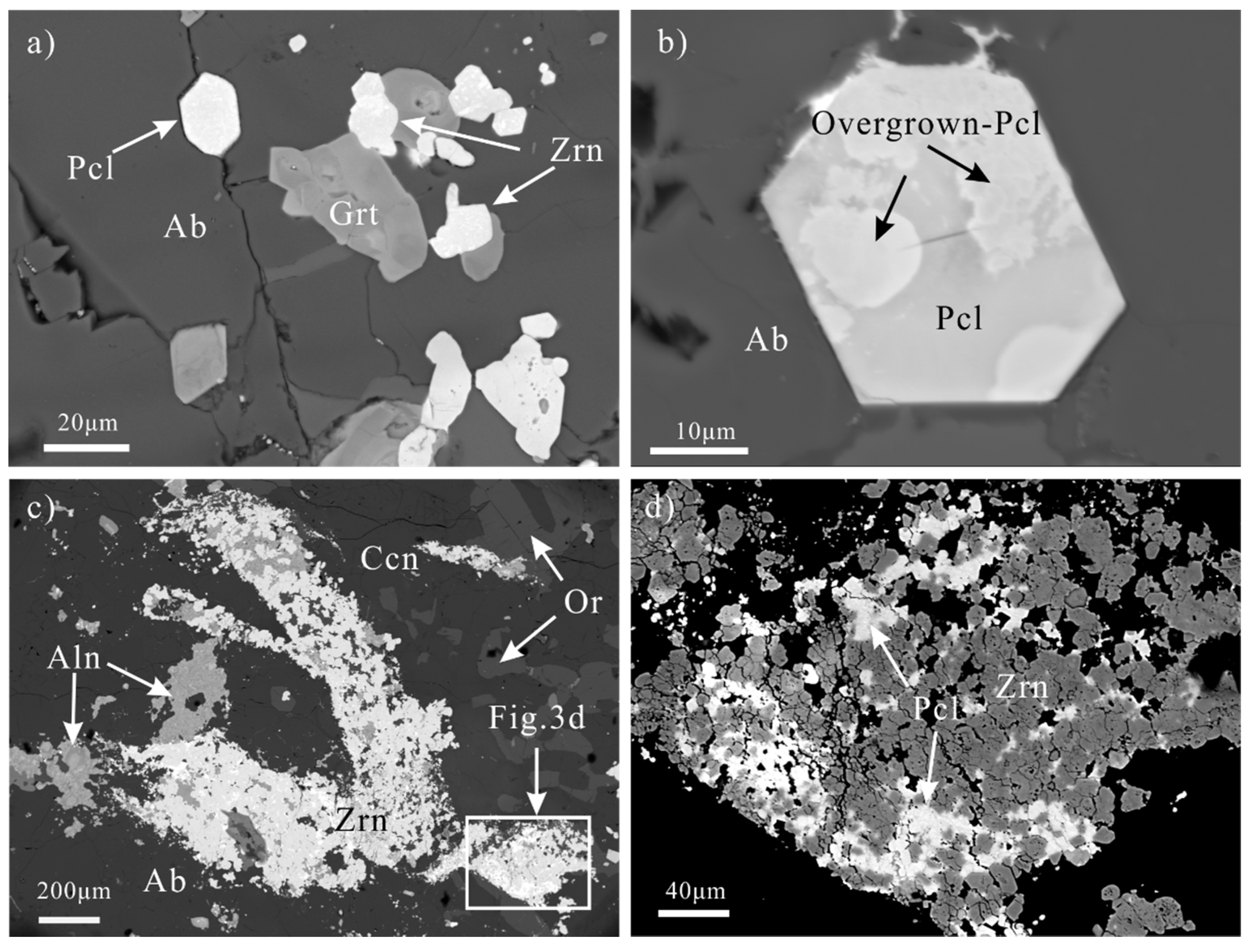
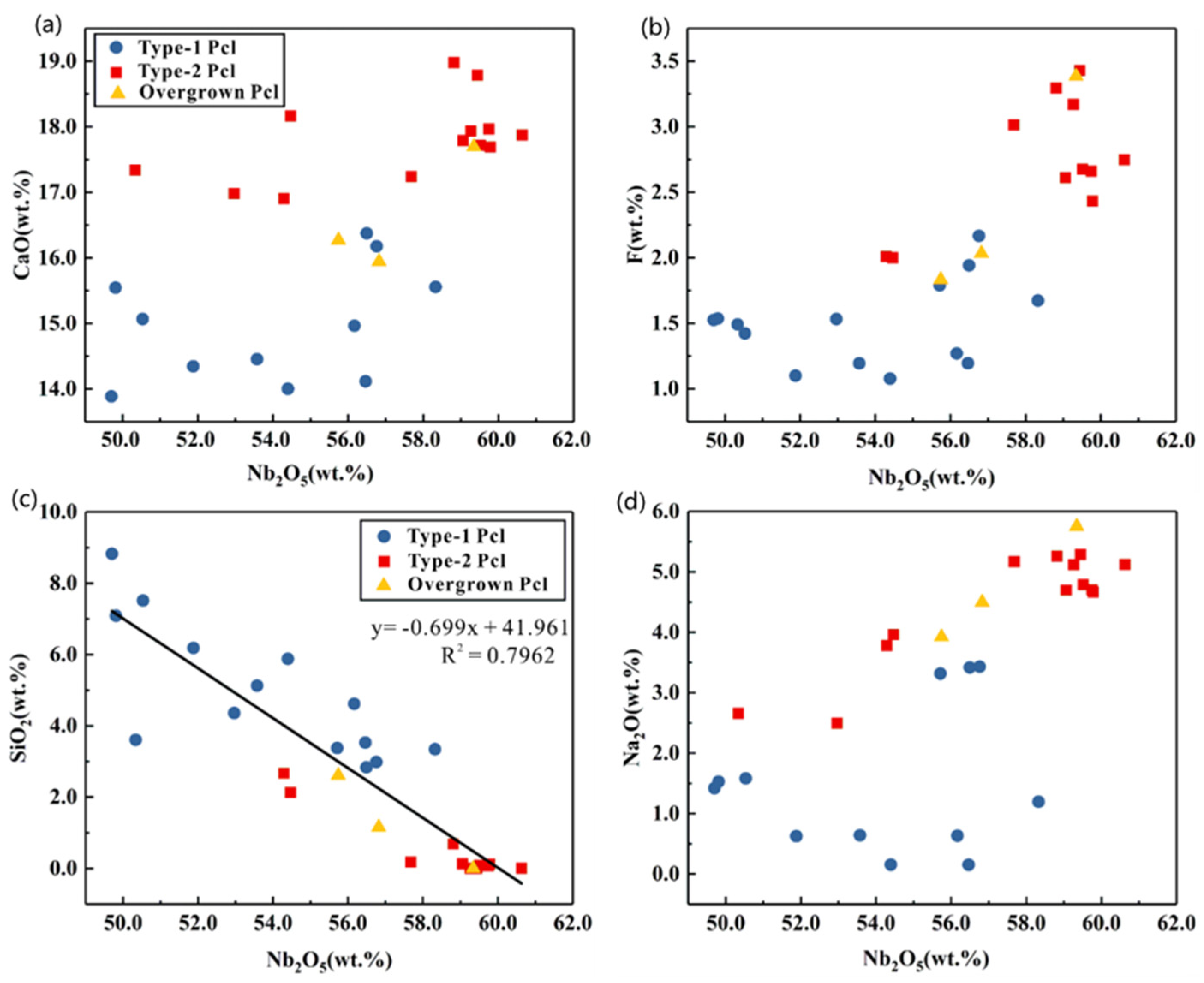
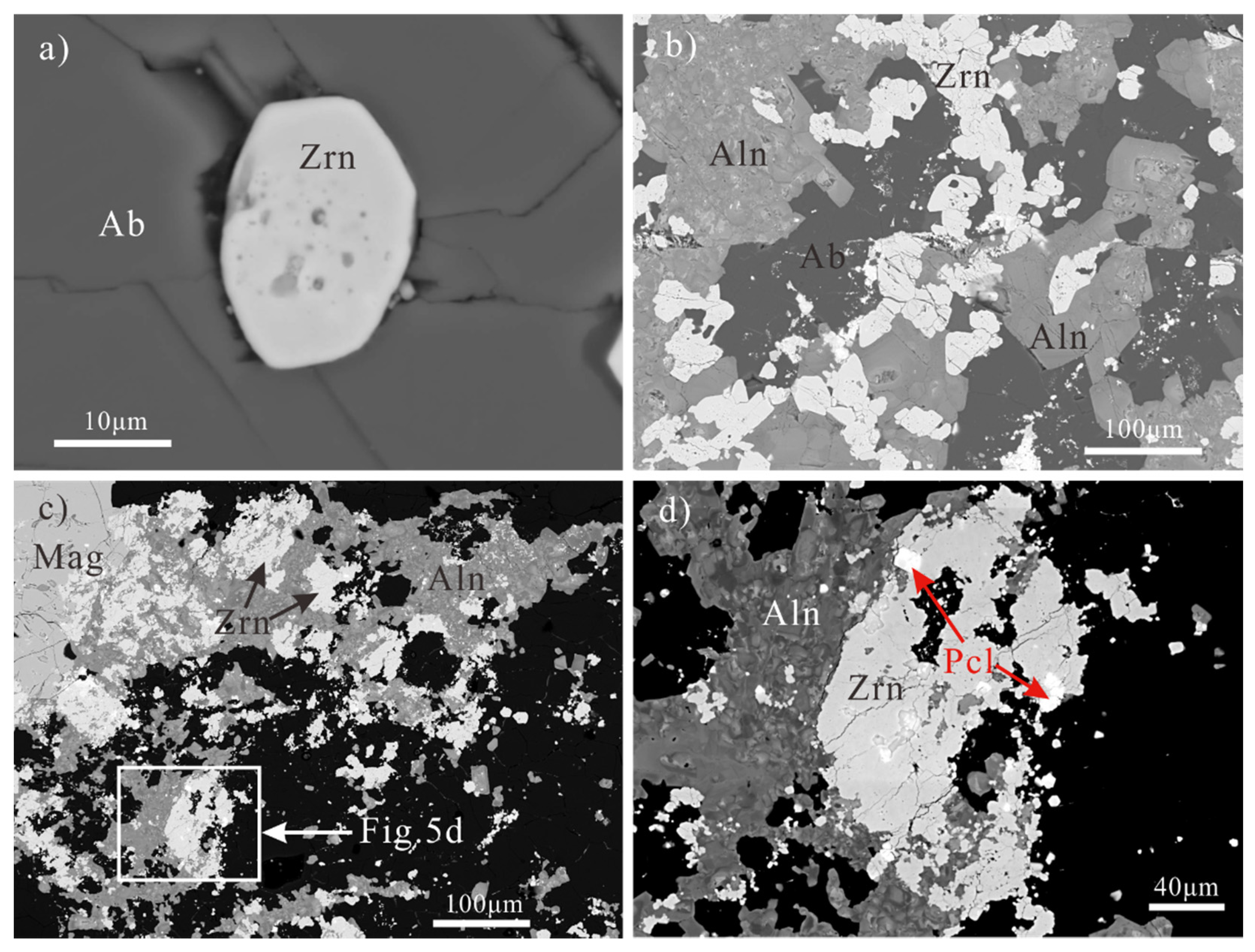
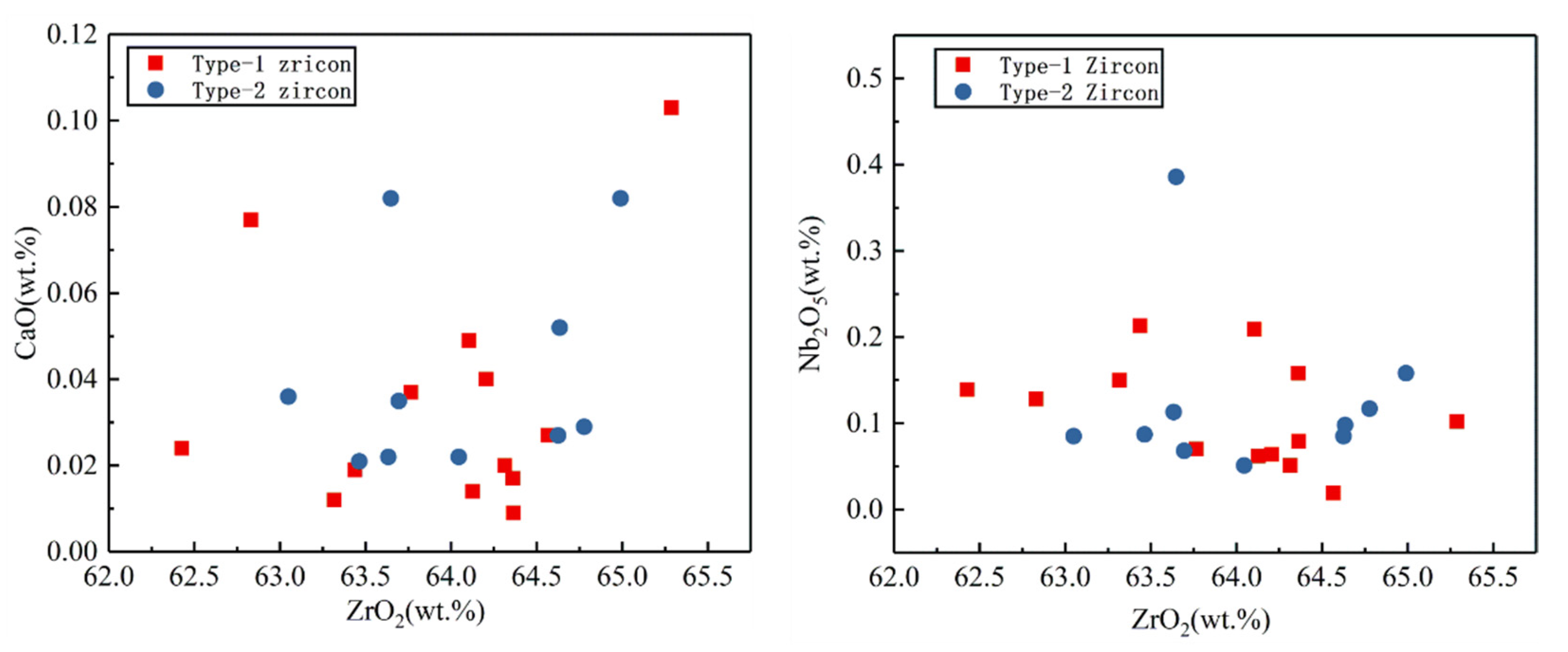
| Pyrochlore Type | Type-1 Pyrochlore | Type-2 Pyrochlore | Overgrown Pyrochlore | ||||||||
|---|---|---|---|---|---|---|---|---|---|---|---|
| Sample No. | 1 | 2 | 3 | 4 | 5 | 6 | 7 | 8 | 9 | 10 | 11 |
| Nb2O5 | 56.17 | 54.39 | 49.70 | 50.53 | 60.63 | 59.06 | 59.44 | 59.78 | 55.74 | 56.82 | 59.34 |
| Ta2O5 | 2.56 | 2.83 | 2.31 | 2.17 | 1.86 | 2.39 | 2.49 | 2.05 | 2.62 | 2.57 | 2.08 |
| TiO2 | 8.06 | 7.88 | 7.28 | 7.30 | 8.54 | 8.61 | 7.71 | 8.61 | 8.09 | 8.45 | 8.39 |
| SiO2 | 4.62 | 5.88 | 8.83 | 7.52 | - | 0.13 | - | 0.12 | 2.61 | 1.16 | - |
| Al2O3 | 0.94 | 1.31 | 2.60 | 1.89 | - | 0.06 | 0.05 | 0.12 | 0.75 | 0.17 | 0.05 |
| FeO | 0.74 | 0.77 | 0.12 | 0.46 | - | - | 0.25 | - | - | - | 0.10 |
| MnO | 0.59 | 0.53 | 0.04 | 0.76 | 0.03 | - | - | 0.03 | 0.15 | 0.06 | - |
| Na2O | 0.64 | 0.16 | 1.42 | 1.58 | 5.12 | 4.70 | 5.29 | 4.67 | 3.92 | 4.50 | 5.75 |
| Y2O3 | 0.20 | 0.13 | 0.30 | 0.40 | 0.37 | 0.39 | 0.25 | 0.39 | 0.51 | 0.46 | 0.33 |
| SrO | 1.14 | 1.19 | 0.40 | 0.40 | 0.06 | 0.09 | 0.28 | 0.04 | 0.07 | 0.18 | 0.04 |
| K2O | 0.60 | 0.42 | 0.58 | 0.32 | - | - | - | 0.02 | 0.12 | 0.02 | - |
| CaO | 14.97 | 14.00 | 13.89 | 15.07 | 17.88 | 17.79 | 18.79 | 17.69 | 16.27 | 15.95 | 17.70 |
| UO2 | 1.59 | 1.99 | 2.38 | 1.68 | 1.84 | 1.79 | 1.65 | 1.93 | 2.42 | 2.35 | 1.85 |
| PbO | 0.41 | 0.32 | 0.37 | 0.58 | 0.44 | 0.39 | 0.38 | 0.45 | 0.49 | 0.37 | 0.44 |
| F | 1.27 | 1.08 | 1.53 | 1.42 | 2.75 | 2.61 | 3.43 | 2.43 | 1.83 | 2.03 | 3.39 |
| H2O* | 2.24 | 2.39 | 2.31 | 2.22 | 1.27 | 1.31 | 0.87 | 1.42 | 1.79 | 1.59 | 0.93 |
| F=O | 0.53 | 0.45 | 0.64 | 0.60 | 1.15 | 1.10 | 1.44 | 1.02 | 0.77 | 0.85 | 1.42 |
| Total | 96.19 | 94.80 | 93.45 | 92.08 | 99.66 | 98.25 | 99.45 | 98.72 | 96.63 | 95.84 | 98.96 |
| Structural Formulae | |||||||||||
| Nb | 1.34 | 1.27 | 1.11 | 1.18 | 1.60 | 1.57 | 1.61 | 1.58 | 1.42 | 1.51 | 1.59 |
| Ta | 0.04 | 0.04 | 0.03 | 0.03 | 0.03 | 0.04 | 0.04 | 0.03 | 0.04 | 0.04 | 0.03 |
| Ti | 0.32 | 0.31 | 0.27 | 0.28 | 0.37 | 0.38 | 0.35 | 0.38 | 0.34 | 0.37 | 0.37 |
| Si | 0.24 | 0.30 | 0.44 | 0.39 | - | 0.01 | - | 0.01 | 0.15 | 0.07 | - |
| Al | 0.06 | 0.08 | 0.15 | 0.12 | - | - | - | 0.01 | 0.05 | 0.01 | - |
| Fe | 0.03 | 0.03 | 0.01 | 0.02 | - | - | 0.01 | - | - | - | 0.01 |
| Mn | 0.03 | 0.02 | - | 0.03 | - | - | - | - | 0.01 | - | - |
| Na | 0.07 | 0.02 | 0.14 | 0.16 | 0.58 | 0.54 | 0.61 | 0.53 | 0.43 | 0.51 | 0.66 |
| Y | 0.01 | - | 0.01 | 0.01 | 0.01 | 0.01 | 0.01 | 0.01 | 0.02 | 0.01 | 0.01 |
| Sr | 0.04 | 0.04 | 0.01 | 0.01 | - | - | 0.01 | - | - | 0.01 | - |
| K | 0.04 | 0.03 | 0.04 | 0.02 | - | - | - | - | 0.01 | - | - |
| Ca | 0.85 | 0.78 | 0.74 | 0.84 | 1.12 | 1.12 | 1.21 | 1.11 | 0.98 | 1.00 | 1.12 |
| U | 0.02 | 0.02 | 0.03 | 0.02 | 0.02 | 0.02 | 0.02 | 0.03 | 0.03 | 0.03 | 0.02 |
| Pb | 0.01 | - | 0.01 | 0.01 | 0.01 | 0.01 | 0.01 | 0.01 | 0.01 | 0.01 | 0.01 |
| F | 0.21 | 0.18 | 0.24 | 0.23 | 0.51 | 0.49 | 0.65 | 0.45 | 0.33 | 0.38 | 0.63 |
| OH | 0.79 | 0.82 | 0.76 | 0.77 | 0.49 | 0.52 | 0.35 | 0.55 | 0.67 | 0.62 | 0.37 |
| No. | 1 | 2 | 3 | 4 | 5 | 6 | 7 | 8 | 9 | 10 | 11 | 12 | 13 | 14 | 15 | 16 | 17 | 18 | 19 | 20 |
|---|---|---|---|---|---|---|---|---|---|---|---|---|---|---|---|---|---|---|---|---|
| ZrO2 | 63.46 | 64.63 | 63.65 | 64.78 | 64.05 | 63.69 | 64.99 | 63.63 | 63.05 | 64.63 | 63.44 | 62.43 | 62.83 | 63.32 | 64.36 | 64.36 | 63.77 | 64.21 | 64.57 | 64.13 |
| Nb2O5 | 0.09 | 0.10 | 0.39 | 0.12 | 0.05 | 0.07 | 0.16 | 0.11 | 0.09 | 0.09 | 0.21 | 0.14 | 0.13 | 0.15 | 0.16 | 0.08 | 0.07 | 0.06 | 0.02 | 0.06 |
| CaO | 0.02 | 0.05 | 0.08 | 0.03 | 0.02 | 0.04 | 0.08 | 0.02 | 0.04 | 0.03 | 0.02 | 0.02 | 0.08 | 0.01 | 0.02 | 0.01 | 0.04 | 0.04 | 0.03 | 0.01 |
| Y2O3 | - | - | 0.19 | - | 0.08 | 0.17 | - | 0.01 | - | - | 0.21 | 0.23 | 0.15 | 0.06 | 0.15 | - | - | 0.10 | - | - |
| SiO2 | 33.55 | 33.66 | 33.43 | 33.82 | 33.63 | 33.88 | 33.58 | 33.41 | 33.46 | 33.40 | 33.94 | 34.02 | 34.12 | 34.07 | 33.96 | 33.63 | 33.65 | 33.26 | 33.92 | 33.80 |
| La2O3 | - | - | - | - | - | - | 0.06 | - | 0.04 | - | - | - | - | 0.05 | - | - | - | 0.06 | - | - |
| Ce2O3 | - | - | - | - | - | 0.03 | - | - | 0.03 | - | - | - | - | 0.05 | 0.03 | - | - | 0.03 | - | - |
| HfO2 | 1.39 | 1.34 | 1.31 | 1.43 | 1.35 | 1.36 | 1.41 | 1.37 | 1.39 | 1.46 | 1.12 | 1.08 | 1.28 | 1.34 | 1.27 | 1.40 | 1.25 | 1.25 | 1.43 | 1.23 |
| Total | 98.51 | 99.78 | 99.05 | 100.18 | 99.18 | 99.24 | 100.28 | 98.55 | 98.1 | 99.61 | 98.94 | 97.92 | 98.59 | 99.05 | 99.95 | 99.48 | 98.78 | 99.01 | 99.97 | 99.23 |
| Structural Formulae | ||||||||||||||||||||
| Zr | 0.953 | 0.960 | 0.952 | 0.959 | 0.956 | 0.949 | 0.963 | 0.956 | 0.951 | 0.964 | 0.946 | 0.937 | 0.938 | 0.943 | 0.953 | 0.959 | 0.954 | 0.963 | 0.956 | 0.955 |
| Nb | 0.001 | 0.001 | 0.005 | 0.002 | 0.001 | 0.001 | 0.002 | 0.002 | 0.001 | 0.001 | 0.003 | 0.002 | 0.002 | 0.002 | 0.002 | 0.001 | 0.001 | 0.001 | - | 0.001 |
| Ca | 0.001 | 0.002 | 0.003 | 0.001 | 0.001 | 0.001 | 0.003 | 0.001 | 0.001 | 0.001 | 0.001 | 0.001 | 0.003 | - | 0.001 | - | 0.001 | 0.001 | 0.001 | - |
| Y | - | - | 0.003 | - | 0.001 | 0.003 | - | - | - | - | 0.003 | 0.004 | 0.002 | 0.001 | 0.002 | - | - | 0.002 | - | - |
| Si | 1.033 | 1.026 | 1.026 | 1.026 | 1.030 | 1.035 | 1.020 | 1.029 | 1.035 | 1.021 | 1.038 | 1.048 | 1.045 | 1.041 | 1.031 | 1.027 | 1.033 | 1.023 | 1.030 | 1.033 |
| La | - | - | - | - | - | - | 0.001 | - | - | - | - | - | - | 0.001 | - | - | - | 0.001 | - | - |
| Ce | - | - | - | - | - | - | - | - | - | - | - | - | - | 0.001 | - | - | - | - | - | - |
| Hf | 0.012 | 0.012 | 0.011 | 0.012 | 0.012 | 0.012 | 0.012 | 0.012 | 0.012 | 0.013 | 0.010 | 0.009 | 0.011 | 0.012 | 0.011 | 0.012 | 0.011 | 0.011 | 0.012 | 0.011 |
| No. | 1 | 2 | 3 | 4 | 5 | 6 | 7 | 8 | 9 | 10 |
|---|---|---|---|---|---|---|---|---|---|---|
| Nb2O5 | 1.12 | 1.57 | 1.63 | 1.51 | 1.52 | 1.22 | 1.39 | 1.10 | 1.03 | 1.53 |
| TiO2 | 27.71 | 27.68 | 28.43 | 28.35 | 29.03 | 28.31 | 31.21 | 28.26 | 29.91 | 29.30 |
| Al2O3 | 7.41 | 7.35 | 6.94 | 6.75 | 6.40 | 7.15 | 4.87 | 7.15 | 6.05 | 6.33 |
| Y2O3 | 0.40 | 0.35 | 0.35 | 0.34 | 0.38 | 0.34 | 0.56 | 0.32 | 0.25 | 0.39 |
| SiO2 | 30.85 | 30.85 | 30.71 | 30.76 | 30.74 | 30.83 | 30.38 | 30.71 | 30.81 | 30.59 |
| Fe2O3 | 1.12 | 1.10 | 1.08 | 1.09 | 1.06 | 1.12 | 1.39 | 1.12 | 1.10 | 1.05 |
| CaO | 28.20 | 28.13 | 27.91 | 28.21 | 28.21 | 28.33 | 27.69 | 28.32 | 28.26 | 27.96 |
| MnO | 0.23 | 0.23 | 0.22 | 0.21 | 0.20 | 0.25 | 0.16 | 0.22 | 0.23 | 0.17 |
| F | 2.36 | 2.09 | 2.33 | 2.05 | 1.90 | 2.00 | 1.69 | 2.28 | 1.73 | 1.77 |
| F=O | 0.99 | 0.88 | 0.98 | 0.86 | 0.80 | 0.84 | 0.71 | 0.96 | 0.73 | 0.74 |
| Total | 98.41 | 98.47 | 98.61 | 98.41 | 98.65 | 98.70 | 98.62 | 98.51 | 98.65 | 98.33 |
| Structural Formulae | ||||||||||
| Nb | 0.02 | 0.02 | 0.02 | 0.02 | 0.02 | 0.02 | 0.02 | 0.02 | 0.01 | 0.02 |
| Ti | 0.67 | 0.67 | 0.69 | 0.69 | 0.70 | 0.68 | 0.76 | 0.68 | 0.72 | 0.71 |
| Al | 0.28 | 0.28 | 0.26 | 0.26 | 0.24 | 0.27 | 0.19 | 0.27 | 0.23 | 0.24 |
| Y | 0.01 | 0.01 | 0.01 | 0.01 | 0.01 | 0.01 | 0.01 | 0.01 | - | 0.01 |
| Si | 0.99 | 0.99 | 0.99 | 0.99 | 0.99 | 0.99 | 0.98 | 0.99 | 0.99 | 0.99 |
| Fe | 0.06 | 0.06 | 0.06 | 0.06 | 0.06 | 0.06 | 0.08 | 0.06 | 0.06 | 0.06 |
| Ca | 0.97 | 0.97 | 0.96 | 0.97 | 0.97 | 0.97 | 0.96 | 0.97 | 0.97 | 0.97 |
| Mn | 0.01 | 0.01 | 0.01 | 0.01 | 0.01 | 0.01 | - | 0.01 | 0.01 | - |
| F | 0.24 | 0.21 | 0.24 | 0.21 | 0.19 | 0.20 | 0.17 | 0.23 | 0.18 | 0.18 |
| (O,OH) | 0.76 | 0.79 | 0.76 | 0.79 | 0.81 | 0.80 | 0.83 | 0.77 | 0.82 | 0.82 |
| Temperature | 600 °C | 500 °C | |
|---|---|---|---|
| Total Content of Nb2O5 in Nepheline Syenite (ppm) | |||
| Initially in melt | 1000 | 1000 | |
| At pyrochlore saturation | 1000 | 150 | |
| Nb2O5 Content of Minerals (ppm) | DNb * | ||
| K-feldspar (60%) | 18.00 | 2.70 | 0.03 |
| Albite (10%) | 3.00 | 0.45 | 0.03 |
| Nepheline (20%) | 6.00 | 0.90 | 0.03 |
| Amphibole (4%) | 3.76 | 0.56 | 0.094 |
| Biotite (2%) | 64.00 | 9.60 | 3.2 |
| Titanite (1.23%) | 200.49 | 30.07 | 16.3 |
| Magnetite (1%) | 1.10 | 0.17 | 0.11 |
| Zircon (0.72%) | 28.08 | 4.21 | 3.9 |
| Pyrochlore | 675.57 | 951.34 | |
| Nb2O5 in other minerals (ppm) | 324.43 | 48.66 | |
| Nb as pyrochlore (% of total) | 67.56 | 95.13 | |
Publisher’s Note: MDPI stays neutral with regard to jurisdictional claims in published maps and institutional affiliations. |
© 2021 by the authors. Licensee MDPI, Basel, Switzerland. This article is an open access article distributed under the terms and conditions of the Creative Commons Attribution (CC BY) license (https://creativecommons.org/licenses/by/4.0/).
Share and Cite
Wang, H.; Tang, Y.; Xu, Y.-S.; Zhang, H.; Lv, Z.-H.; Qin, S.-X.; Song, Y.-W. Textures and Chemical Compositions of Nb-Bearing Minerals and Nb Mineralization in the Shuangshan Nepheline Syenite Pluton, East Qinling, China. Minerals 2021, 11, 1163. https://doi.org/10.3390/min11111163
Wang H, Tang Y, Xu Y-S, Zhang H, Lv Z-H, Qin S-X, Song Y-W. Textures and Chemical Compositions of Nb-Bearing Minerals and Nb Mineralization in the Shuangshan Nepheline Syenite Pluton, East Qinling, China. Minerals. 2021; 11(11):1163. https://doi.org/10.3390/min11111163
Chicago/Turabian StyleWang, Hong, Yong Tang, Yu-Sheng Xu, Hui Zhang, Zheng-Hang Lv, Shan-Xian Qin, and Ying-Wei Song. 2021. "Textures and Chemical Compositions of Nb-Bearing Minerals and Nb Mineralization in the Shuangshan Nepheline Syenite Pluton, East Qinling, China" Minerals 11, no. 11: 1163. https://doi.org/10.3390/min11111163
APA StyleWang, H., Tang, Y., Xu, Y.-S., Zhang, H., Lv, Z.-H., Qin, S.-X., & Song, Y.-W. (2021). Textures and Chemical Compositions of Nb-Bearing Minerals and Nb Mineralization in the Shuangshan Nepheline Syenite Pluton, East Qinling, China. Minerals, 11(11), 1163. https://doi.org/10.3390/min11111163






